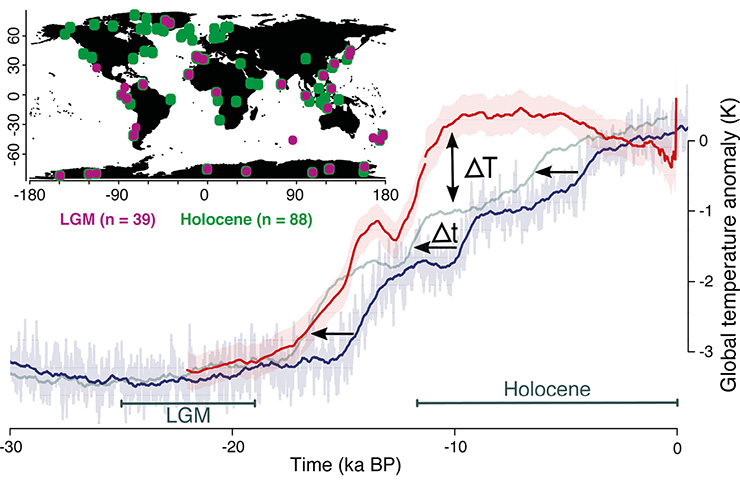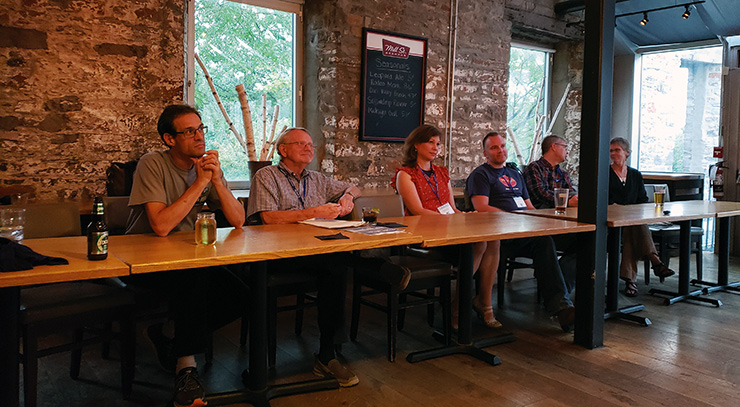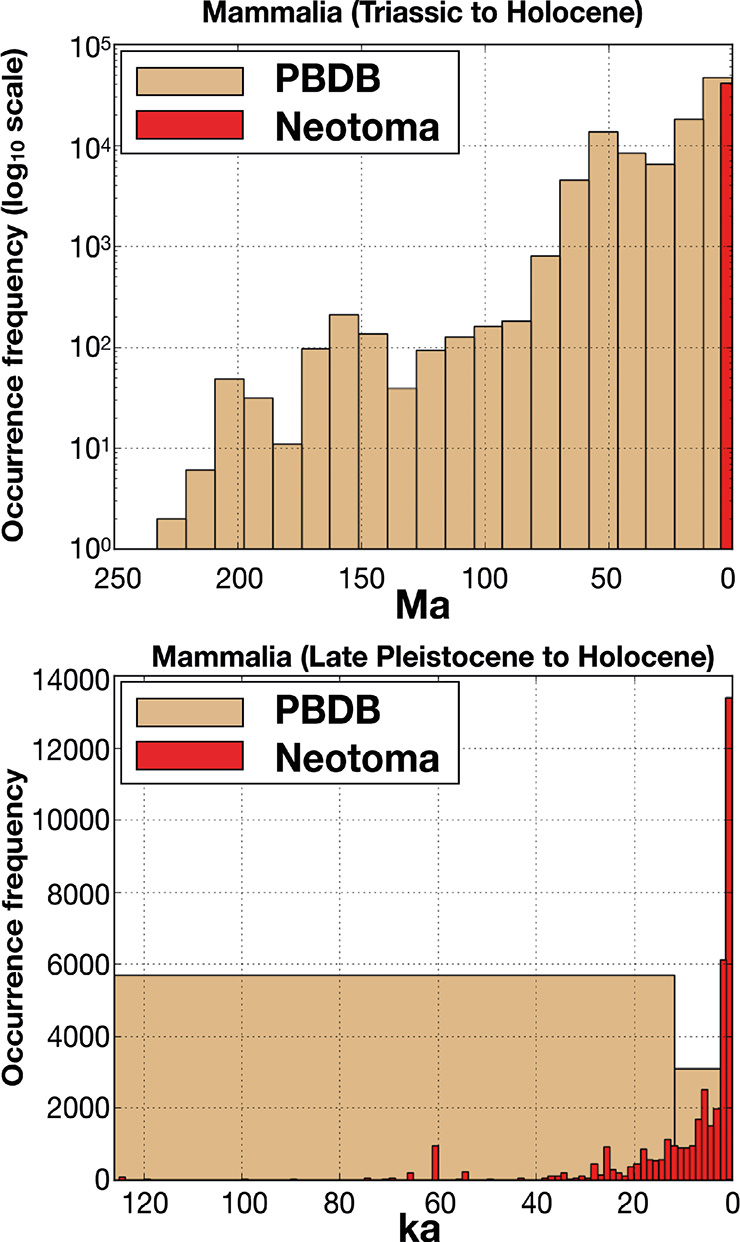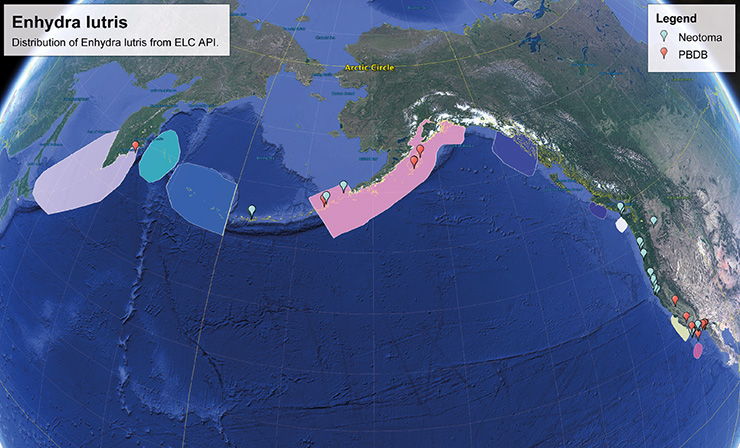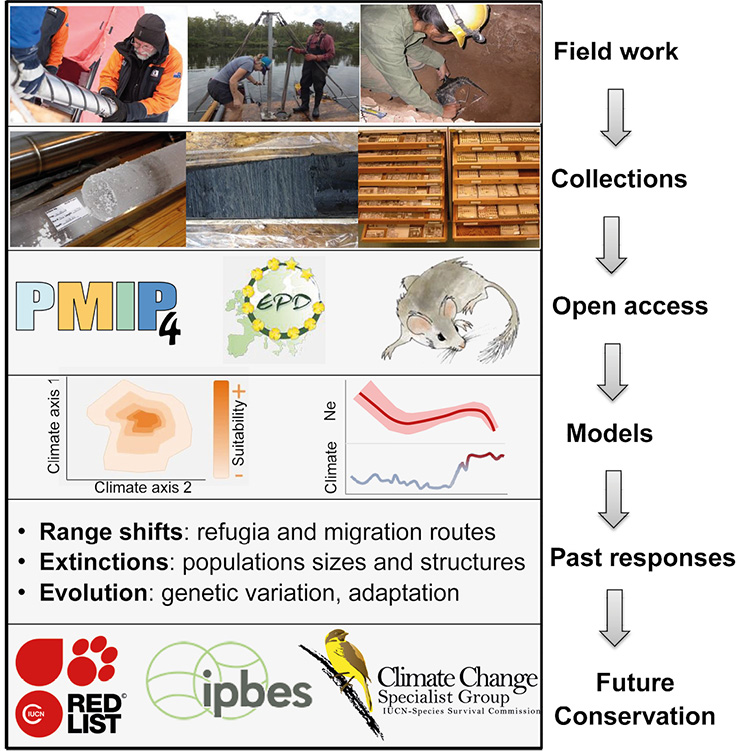- Home
- Taxonomy
- Term
- PAGES Magazine Articles
PAGES Magazine articles
Publications
PAGES Magazine articles
2018
Past Global Changes Magazine
Rebecca Hamilton1, T. Brussel2, Q. Asena3, R. Bruél4, K. Marcisz5, M. Słowiński6 and J. Morris7
2nd EcoRe3 workshop, Salt Lake City, USA, 8-10 May 2018
Functional traits are integral to understanding the patterns and drivers of ecological resilience. Response traits determine whether a system exhibits properties resulting in higher resistance or faster recovery rates, while effects traits are important for identifying links between environmental changes and ecosystem functioning. Although paleoecological research methods have been identified as an important tool for understanding patterns of ecological resilience across different regions, paleoecologists have only recently begun to think about how functional ecological approaches can be used in the context of sub-fossil assemblages from sediments. Thus, the second EcoRe3 workshop aimed to (i) explore developments in modeling ecosystem resilience from the paleorecord, and (ii) investigate the development of new tools to link paleoecological datasets with functional trait databases derived from neo-ecological research.
These two themes were investigated over two days at the Natural History Museum of Utah in the form of presentations and semi-structured discussion groups. Twenty-two participants from nine countries attended the meeting, with funding provided by PAGES and the Research Council of Norway. Research covered in the meeting was diverse with respect to the ecosystems studied, proxies (pollen, Cladocera, testate amoebae, diatoms) and timescales interrogated, and modeling methodologies applied. The diversity of approaches highlighted advancements the working group had made in measuring long-term patterns of ecosystem resilience since the last meeting.
Presentations themed around modeling resilience from long-term ecological data showcased progress in the development of novel techniques for measuring critical transitions, and presented particular records that serve as interesting case studies for the exploration of aspects of resilience. They highlighted the value of high-resolution data (taxonomic and temporal) that capture ecological regime shifts and/or clearly identifiable drivers of change for examination of ecological thresholds and response rates.
Further progression in using paleoecology for measuring resilience requires improvements in the capacity of associated research to capture individual and collective functional traits that can be related to the resistance or recovery rate of an ecosystem following disturbance. This is particularly apparent where no critical thresholds are breached, when there is a lead- or lag-proxy response to drivers of change, or when multiple stressors operating at different time scales are involved. Several presentations therefore sought to explore these issues via (1) case-studies focused on the role that particular traits play in resistance to, or recovery from, disturbance, and (2) demonstrating techniques for measuring changes in functional trait space through time, and linking these to ecological resilience.
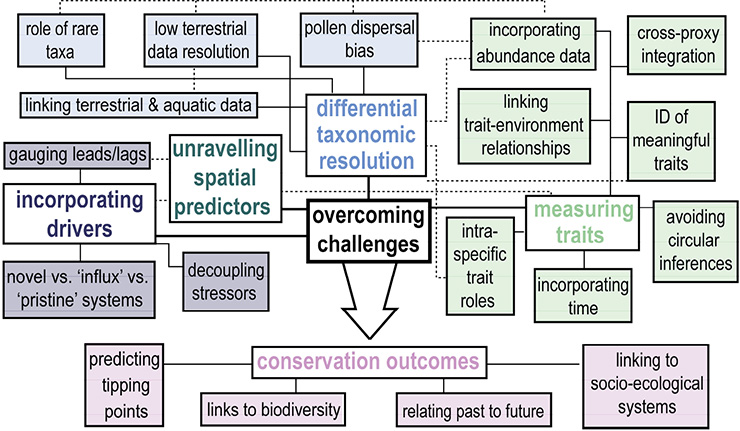 |
|
Figure 1: Key challenges to be resolved in paleoecology related to function and measuring resilience to advance conservation outcomes. |
While these presentations elucidated the importance of response and effect traits in controlling ecosystem function, it became apparent that there are several hurdles to overcome to progress the field of functional paleoecology and resilience. A horizon scan of key issues pertaining to what these challenges comprise, and how they can be resolved, was the key focus of the workshop discussion groups (Fig. 1). Identifying which traits are both ecologically meaningful and quantifiable in the sediment record was highlighted as a major challenge for many microfossil types. Linked to this are issues related to differential (or low) taxonomic resolution, and quantification of drivers that require the development of a unique set of analytical approaches if functional ecological approaches are applied to paleoecological data. The final discussions centered on the potential to advance understanding related to conservation outcomes if these technical challenges can be overcome. An in-depth analysis of these challenges and the solutions required to overcome them form the basis of an upcoming EcoRe3 perspective paper.
The workshop concluded with a discussion regarding EcoRe3’s future steps, including (1) the publication of a special issue based on the overall goals in 2019, and (2) regrouping the members for a themed session at INQUA 2019 in Dublin, Ireland. A follow-up workshop, focused around the statistical modeling of paleo datasets using techniques developed within EcoRe3, was also proposed. Details of future EcoRe3 activities will be updated on the website (pastglobalchanges.org/ecore3) and on the following social media outlets.
• EcoRe3 on Facebook (visit page and request to join): facebook.com/groups/286999515057710
• EcoRe3 on Twitter: @Eco_Re3
• EcoRe3 on ResearchGate: researchgate.net/project/EcoRe3-Resistance-Recovery-and-Resilience-in-Long-term-Ecological-Systems-2
affiliations
1School of Culture, History & Language, The Australian National University, Canberra, Australia
2Geography Department, University of Utah, Salt Lake City, USA
3School of Environment, University of Auckland, New Zealand
4UMR CARRTEL, INRA-Université Savoie Mont-Blanc, Thonon-les-bains, France
5Laboratory of Wetland Ecology and Monitoring and Department of Biogeography and Palaeoecology, Adam Mickiewicz University, Poznań, Poland
6Department of Environmental Resources and Geohazards, Polish Academy of Sciences, Warsaw, Poland
7Research Development Office, University of Utah, Salt Lake City, USA
contact
Rebecca Hamilton: rebecca.hamilton anu.edu.au (rebecca[dot]hamilton[at]anu[dot]edu[dot]au)
anu.edu.au (rebecca[dot]hamilton[at]anu[dot]edu[dot]au)
Publications
PAGES Magazine articles
2018
Past Global Changes Magazine
Jesse Morris1, J. Clear2, R. Chiverell3, R.J. DeRose4 and I. Drobychev5
Liverpool, UK, 21-23 March 2017
Disturbance events, such as wildfire and bark beetle outbreaks, are natural processes that promote forest regeneration and succession. As climate change propels ecosystems and disturbance regimes along new trajectories, retrospective ecological records, like those derived from tree rings and lake sediments, become important in understanding and anticipating future environmental change. Paleoenvironmental records are essential to inform conservation and management efforts to characterize baseline ecosystem services and recovery rates from disturbances.
In March 2017, PAGES’ Forest Dynamics working group assembled a team of 29 scientists, including 14 early-career researchers, from 13 nations to explore new approaches to reconstructing forest disturbances. The workshop occurred at Liverpool Hope University (UK). The first workshop day was in conference format where participants gave research talks in themed oral presentation sessions. The second day was organized around group discussions that explored four broad themes:
(1) Improving reconstructions of non-fire disturbances
While advances have occurred in recent decades in the reconstruction of paleofires from tree-ring and lake-sediment records, non-fire disturbance events, such as insect and pathogen outbreaks, are largely unaccounted in paleoenvironmental studies. Non-fire disturbances are important drivers of forest succession, yet they are challenging to reconstruct because indicators that conclusively diagnose the disturbance are infrequently recovered, as in the case with bark beetles (Morris et al. 2015). However, increasing the volume of sediment sub-samples (Whitehouse et al. 2010) may enhance macrofossil recovery, including insect remains, which would improve their utility as a proxy for outbreak events. Recent work by Stivrins et al. (2017) provides an encouraging example in reconstructing non-fire disturbances, where the authors identified and counted non-pollen palynomorphs from a fungal pathogen (Phytophthora) to explain the decline of alder (Alnus spp.) in Europe during the medieval period.
(2) Reconstructing the severity of forest disturbances
Discussions centered on how to better integrate lake-sediment proxies with tree-ring and forest-inventory data. In some instances, forest-inventory records have been combined with pollen records to produce estimates of past forest cover as aboveground biomass (Seppä et al. 2009). A key advance in assessing past disturbances centers on the quantifying tree mortality resulting from the event (i.e. severity). Biomass may aid in quantifying the severity of plant mortality as a result of a disturbance. Severity reconstructions could be enhanced by integrating mortality data from individual trees (tree rings), stands (forest hollows) to landscapes (lakes).
(3) Opportunities for database integration
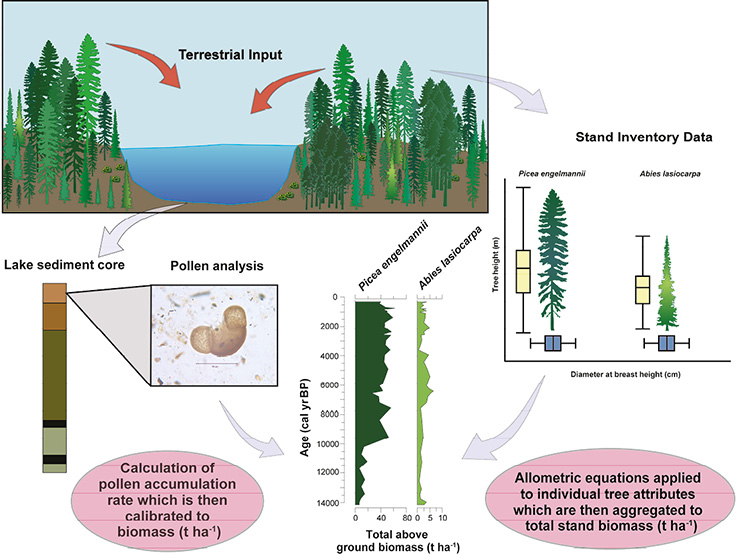 |
|
Figure 1: Conceptualization of transforming pollen data to biomass (t/ha) using stand demographic data. |
One practical approach to determining potential sites to link records of forest dynamics would be to integrate existing databases. For example, integrating databases through geolocation would simplify the identification of study areas for synergistic work. Several databases were discussed, including Neotoma (neotomadb.org), the NOAA National Centers for Environmental Information (ncdc.noaa.gov/paleo), and forest inventory databases, such as the USDA Forest Inventory and Analysis (fia.fs.fed.us/tools-data). Database integration presents a key opportunity to advance reconstructions of past forest conditions, especially in leveraging quantitative approaches to reconstruct land cover (Fig. 1).
(4) Key methods for data integration
The final discussion centered on new methods for integrating lake-sediment proxy data across scales. Generally, data integration across scales can be challenging even when using a single proxy (e.g. pollen). Examples from the first day’s presentations were highlighted. Quantitative pollen techniques, such as the Landscape Reconstruction Algorithm (LRA) (Sugita 2007), help to compare vegetation reconstructions across spatial and temporal scales, though with noted issues (Trondman et al. 2016). Recently, Carter et al. (2018) used the LRA approach to integrate pollen profiles from 10 peat bogs with four lake records to reconstruct total land-cover abundance across local- to regional-scales. Their approach provides information that is relevant for conversation and ecosystem management strategies in Central Europe.
Future activities
The next Forst Dynamics' activity will be to write a synthesis paper with the working title “Pairing dendrochronological and paleoecological approaches to reconstructing past disturbances events.”
acknowledgements
This workshop was supported by PAGES and the Liverpool Hope University.
affiliations
1Department of Geography, University of Utah, Salt Lake City, USA
2Department of Geography, Liverpool Hope University, UK
3Department of Geography, University of Liverpool, UK
4Forest Inventory and Analysis, USDA Forest Service, Ogden, USA
5Swedish University of Agricultural Sciences, Alnarp, Sweden & University of Quebec at Abitibi-Temiscamingue, Canada
contact
Jesse Morris: jesse.morris utah.edu
utah.edu
references
Carter VA et al. (2018) Fron Earth Sci 8: 2268
Morris JL et al. (2015) Quat Int 387: 72-86
Seppä H et al. (2009) Holocene 19: 209-220
Stivrins N et al. (2017) J Quat Sci 32: 903-907
Sugita S (2007) Holocene 17: 229-257
Publications
PAGES Magazine articles
2018
Past Global Changes Magazine
Heather Andres1, O. Bothe2, K. Rehfeld3, S. Wagner2, N. Weitzel4 and E. Zorita2
Hamburg, Germany, 16-18 April 2018
Comparing climate proxy and simulation data is fraught with challenges: age and calibration uncertainties in climate proxies, missing or incomplete processes and uncertain boundary conditions for climate models, and differences between gridded and site data are just a few examples. For the climate of the Common Era, multiple initiatives have already addressed these issues (e.g. the PAGES 2k Network regional working groups). On transient timescales beyond the late Holocene, there have been only a few integrated activities. Comparisons on these longer time scales involve large-scale changes in climate states without an equivalent during the Holocene. As such, they require methods that address both the amplitude and timing of background climate changes and account for additional processes. For example, comprehensive Earth System Models need to include changes in ice sheets and related ocean circulation changes during deglaciation. Likewise, proxy data for this period, such as lake or marine sediments, are generally less well replicated than their late Holocene counterparts (e.g. tree rings and historical documents), resulting in more uncertain climate signals (Laepple et al. 2017).
To address strategies for data-model comparisons on late Pleistocene and Holocene time scales, 30 participants, including global and regional climate modelers, statisticians and proxy experts, gathered in Hamburg for a three-day workshop. The meeting was co-sponsored by the German climate modeling initiative PalMod. The workshop started with overview talks, which provided a solid base for breakout groups. These groups covered three main categories, addressing (i) conceptual aspects of data-model comparisons, (ii) inferring Holocene, and (iii) deglacial climate changes by combining proxies and models.
The methodological breakout group began to develop a framework based on the comparison of probability distributions of both proxy and simulated data, which accounts for quantifiable uncertainties. One of their main objectives was to develop summary metrics that assess the mismatch of reconstructed and simulated climate information and are robust with respect to uncertainties. The Holocene breakout group planned an integrated analysis of different types of proxy data and model simulations for not only hemispheric and global means, but also regions, such as Europe and the North Atlantic. This group focused on apparent model-data mismatches beyond the so-called “Holocene Conundrum” (Liu et al. 2014), like the influence of large scale atmospheric and oceanic processes on regional Holocene climate variability, and discrepancies between the seasonality and regional characteristics of trends in simulations and pollen-based reconstructions. The deglaciation breakout group developed a procedure to evaluate the representation of large-amplitude events in proxies and simulations. This method compares the spatio-temporal structure of an event relative to its onset, and thus allows comparisons of manifestations of internal variability as well as events that occur at different times in the simulations and proxy records. The approach depends on metrics that quantify mismatches in time and space. This breakout group carried out initial testing of their methodology with existing datasets (Fig. 1) and will prepare, with the methodology group, a document with guidelines and a specific description of the algorithm (i.e. a cookbook) to enable others to implement the same procedure.
In addition to the methodological cookbook, workshop attendees planned future activities. These include writing an overview manuscript on the questions formulated in the Holocene breakout group. Additional follow-up plans include an interactive toolbox to compare model simulations with proxies using a hierarchy of metrics with varying complexity.
affiliations
1Department of Physics and Physical Oceanography, Memorial University of Newfoundland, St. John’s, Canada
2Institute of Coastal Research, Helmholtz-Zentrum Geesthacht, Germany
3Institut für Umweltphysik, Universität Heidelberg, Germany
4Institut für Geowissenschaften und Meteorologie, Universität Bonn, Germany
contact
Oliver Bothe: oliver.bothe hzg.de
hzg.de
references
Laepple T et al. (2017) PAGES Mag 25: 140-141
Liu Z et al. (2014) PNAS 111: E3501-E3505
Marcott SA et al. (2013) Science 339: 1198-1201
Rehfeld K et al. (2018) Nature 554: 356-359
Publications
PAGES Magazine articles
2018
Past Global Changes Magazine
Blas Valero-Garcés1, A. Myrbo2, A. Noren2 and C. Jennings2,3
Minneapolis, USA, 24 May 2018
The Department of Earth Sciences, the Continental Scientific Drilling Coordination Office (CSDCO) and LacCore, University of Minnesota (UMN), Minneapolis, USA, hosted a Symposium after the PAGES Scientific Steering Committee (SSC) meeting. As in previous years, the SSC meeting provided an opportunity for local scientists to showcase the research related to past global changes and to interact with PAGES scientists. Minnesota has a long history of paleoclimate and paleoenvironmental research and, in particular, the Limnological Research Center has been a hub for past global changes research and the origin of LacCore and CSDCO (csdco.umn.edu). Following the steps of Herb Wright and Kerry Kelts, both facilities have been instrumental for a large number of lake-core projects in the last decades. The Symposium included 14 talks addressing local to global topics, and discussed several aspects of Quaternary and Anthropocene climate changes and ecosystem responses.
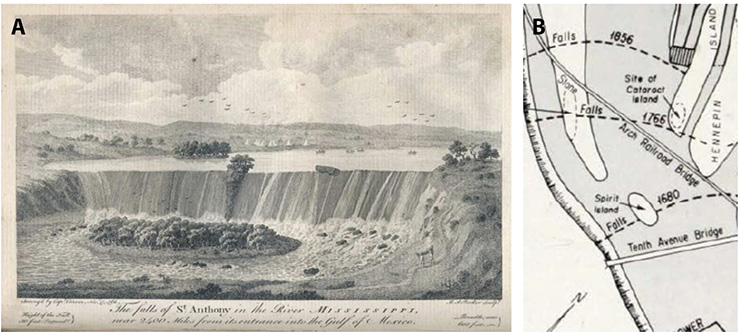 |
|
Figure 1: Left. The Falls of St. Anthony in a 1766 Sketch by Jonathon Carver. Right. The retreat of St. Anthony Falls from 1680 to 1871 after Sardeson, 1916. From Wright (1972). |
At a local scale, Amy Myrbo (UMN) showed the multiple negative consequences of sulfate pollution of freshwater shallow lakes, and how to recognize sulfate loading in the (neo)paleorecord. Randy Calcote (UMN) described several examples of how vegetation patchiness is a major control on ecosystem evolution during the Holocene and has to be considered in our future predictions. Andy Breckenridge (University of Wisconsin-Superior) illustrated how to build a 5,000-year varve chronology from glacial lakes Norwood and Agassiz. And Carrie Jennings (Freshwater Society and UMN) reviewed the Glacial Geology of the Minnesota and Mississippi Rivers (Fig. 1).
At a regional scale, Charles Umbanhowar (St. Olaf College) illustrated the differences between aquatic and terrestrial subarctic ecosystems (Manitoba, Canada) and how they tell mostly the same story at multiple sites. Kelly MacGregor (Macalester College) showed the Holocene landscape dynamics in the Paternoster lakes in Glacier National Park and the later human impacts. Kevin Theissen (St. Thomas University) presented several cases of carbonate lake sequences from Nevada and their isotopic signatures during the Holocene.
At a global scale, Larry Edwards (UMN) summarized the Chinese and Amazon cave sequences and how they pace the monsoon changes and show a clear anti-phase behavior. Larry showed us the newest U/Th and 14C speleothem chronology from several Chinese caves that will help to improve the 14C calibration curve. Emi Ito (UMN) presented the case of Pliocene lakes in Western North America and a possible new International Continental Scientific Drilling Program (ICDP) project. In terms of geobiochemical cycles, Jeff Havig (UMN) reviewed several examples of how to link geochemistry and geobiology in extreme lake and spring environments as found in Yellowstone, and Adam Heathcote (St. Croix Watershed Research Station) showed a review of global trends in carbon burial in lakes. Paul Glaser (UMN) summarized several decades of studies on peatlands and the changing relationship between sea level and peat growth depending on the tectonic settings. To end proceedings, Shane Loeffler (UMN) gave us an overview of Flyover Country®, a US National Science Foundation-funded offline mobile app for geoscience outreach and data discovery (see Myrbo et al., this issue).
Symposium participants toured the CSDCO and LacCore Facility, and Anders Noren (UMN) gave a summary of the support and infrastructure provided to the research community, and examples of recent high-profile projects. These facilities offer expertise in project development, planning, and management; rental equipment for field operations; core lab for processing, scanning, and subsampling; repository for cores, data, publications, and reference collections; support for outreach, diversity, and education activities; community software; and community coordination for long-range science planning. Each year, they provide support to an average of 1,400 scientists from 500 institutions worldwide, and the repository now includes more than 8,000 sites. With roots in the paleolimnology community, these facilities now offer services to continental drilling and coring projects with any scientific focus.
The following day, Carrie Jennings (Freshwater Society and UMN) led a field trip to show the post-glacial evolution of the Minnesota and Mississippi rivers’ valleys. The Minnesota River valley was carved by the draining of glacial Lake Agassiz and it has a wide and active floodplain with dynamic lakes, levees and channels. The Upper Mississippi was one of the first locations where geologists demonstrated the long periods needed for geological processes to operate, as in 1876, when N.H. Winchell calculated that the retreat rate for St. Anthony Falls in Minneapolis was about a meter per year.
affiliations
1Pyrenean Institute of Ecology, Spanish National Research Council, Zaragoza, Spain
2LacCore Facility and Continental Scientific Drilling Coordination Office (CSDCO), University of Minnesota, Minneapolis, USA
3Freshwater Society, St. Paul, USA
contact
Blas Valero-Garcés: blas ipe.csic.es
ipe.csic.es
reference
Publications
PAGES Magazine articles
2018
Past Global Changes Magazine
Brian M. Chase
Nairobi, Kenya, 14-22 July 2018
With support from PAGES and INQUA, the 2nd AFQUA Conference (The African Quaternary: environments, ecology and humans) took place in Nairobi at the National Museum of Kenya. AFQUA was conceived to bridge the existing gap between large international meetings (>500 delegates) and regional African conferences (~50 delegates) and create a forum to share results and foster communication and collaboration at both regional, continental, and international scales. Further, AFQUA recognizes that the global distribution of research and educational funds favors developed-world researchers to become the recognized leaders in African Quaternary studies, but often their interactions with the local scientific communities are limited to their direct collaborators. AFQUA therefore seeks to (1) create a more fully integrated African research network and (2) provide opportunities for African researchers to develop, access, and share capacity that will allow for their participation in research projects at the highest level. AFQUA brings developed- and developing-world researchers together, but it also goes beyond the standard structure of most conferences, with equal time being dedicated to a series of focus groups and training workshops. These include thematic discussions on cutting-edge research topics as well as workshops that introduce and train researchers in the skills they need to develop and communicate their science in the modern research environment.
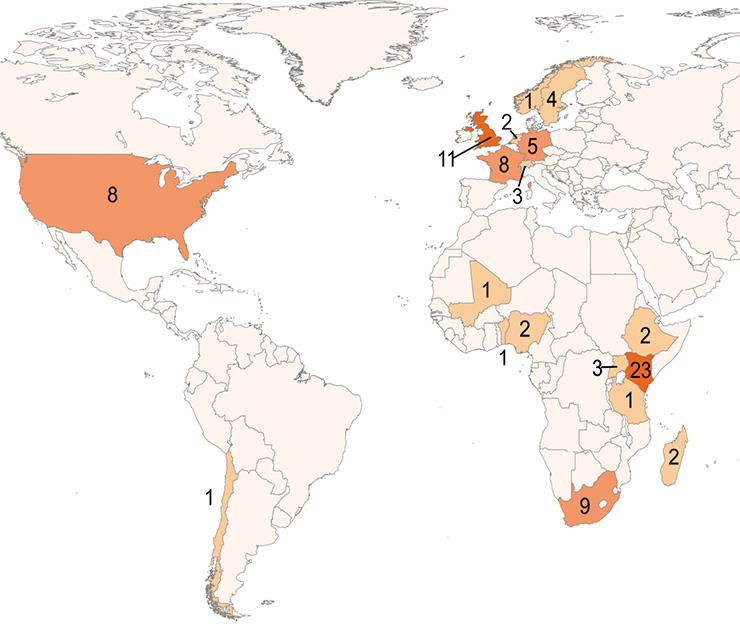 |
|
Figure 1: Distribution of delegates attending the 2018 AFQUA conference in Nairobi, Kenya. |
In Nairobi, 84 researchers from 21 countries came together to share their work from the Pliocene to the projected future, spanning diverse subjects from human evolution, to climate change and vegetation dynamics, fire ecology, risk management, and the history and impacts of humans on their environments. Linking key conference themes with plenaries and sessions, Andy Cohen kicked off the conference showcasing the role that continental drilling of the large East African lake basins has had on our understanding of Quaternary environments in Africa. Subsequent plenaries included Sharon Nicholson discussing African climate change and appropriate ways to use modern systems to understand past climates; Boris Vannière and Daniele Colombaroli highlighting the past and future work of the PAGES Global Paleofire Working Group and the potential for fire ecology research in Africa; David Nash describing how historical documentary sources can be used to study climate-change history and impacts; and Daniel Olago discussing what climate change means in the African context, and how land and water resources may be impacted.
These presentations served as keystones for daily themes, which included papers on regional phenomena from across the continent, as well as papers presented in focus sessions on (1) Quantitative paleoclimatology, modeling and data-model comparisons; (2) The state-of-the-art and perspectives about fire history, fire ecology and fire-vegetation-climate interactions across tropical biomes; (3) The environmental context for hominin evolution and dispersal; (4) African archaeological landscapes; (5) Applying the Quaternary: the role of the past in supporting the future; (6) Dating and correlation of African archives of environmental change and archaeology; and (7) African paleoecology and archaeology perspectives on land-use transformation: Africa LandUse6k.
The PAGES Early-Career Network organized a splinter meeting that gathered 17 participants. Many African early-career researchers discovered the existence of this new network, recognized its potential and expressed a high level of interest to become active members in the future.
Following the five days of presentations, three days of workshops were held to provide training and foster collaboration on research projects. Participants had the opportunity to engage in international drilling programs, improve their knowledge of using lake sediments, animal remains and charcoal to understand paleosystems, learn how to integrate GIS methods in their work, and how to best apply radiocarbon techniques to create reliable chronologies (including the award of five free radiocarbon ages from the 14Chrono Centre to one lucky participant!).
Building on the success of this meeting and the inaugural AFQUA conference held in Cape Town in 2015, we intend to hold the 3rd AFQUA Conference in 2021. If you would like to be added to the AFQUA mailing list, to stay informed about future developments and meetings, please write to us at afqua.congress gmail.com.
gmail.com.
affiliation
Institut des Sciences de l'Evolution-Montpellier, Université de Montpellier, France
contact
Brian M. Chase: Brian.Chase um2.fr
um2.fr
Publications
PAGES Magazine articles
2018
Past Global Changes Magazine
AFQUA-PAGES ECN meeting participants*
Due to its large longitudinal, latitudinal and also altitudinal extent, the African continent crosses different climate zones and therefore hosts extremely diverse environments, such as tropical glaciers in the equatorial region, hyper-arid deserts in its subtropical latitudes, and Mediterranean ecosystems in its northern and southern fringes. Quaternary scientists have long been attracted to Africa not only because of the natural diversity of its environments, flora, and fauna, but also because Africa is the epicenter of human origins and evolution. Quaternary research in Africa therefore offers a unique opportunity to develop and test our understanding of key components of the Earth system at the intersection of past climate change, environments, and humans.
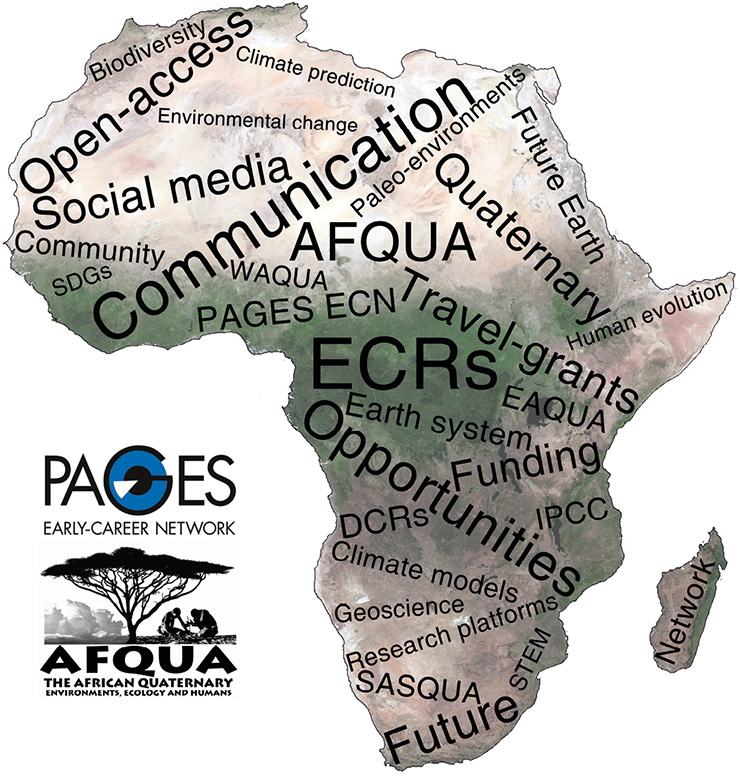 |
|
Figure 1: Word cloud summarizing our lively discussions at AFQUA. |
Unfortunately, despite the great interest in African paleoscience research at a global level, it remains very challenging for African early-career researchers (ECRs) to develop a scientific career in studying their own continent. However, things are positively evolving and more possibilities are now becoming available for African ECRs to conduct Quaternary science with, for instance, the new accelerator mass spectroscopy (AMS) facility at iThemba LABS1 in Johannesburg (South Africa) that invites ECRs to receive training in radiocarbon dating and other analyses, or the Pan African Institutes of Science and Technology in Arusha, Tanzania2, and Abuja, Nigeria3, where research-intensive postgraduate and postdoc studies are carried out.
Opportunities to meet the international community are also more abundant, as most international congresses and workshops now offer travel grants (evaluated on a competitive basis at international levels) that are specifically dedicated to ECRs and researchers from developing countries. Participation in meetings like these is not only essential for keeping abreast with the most recent scientific developments, but is also critical for networking purposes. Recently, the African Quaternary Association4 (AFQUA) community started to develop a series of congresses and training workshops based in Africa to bridge the gap between the regional African communities (such as SASQUA, EAQUA and WAQUA) and the more global communities. During its recent edition held in Nairobi, Kenya, in July 2018 (Chase, this issue), the presentations from the speakers and panel discussions brought to the forefront ideas and concerns, and highlighted some areas for future collaborative work. This provides an optimistic view for ECRs as future research leaders on some of the identified research niches.
However, even though opportunities exist, it is often challenging for African-based ECRs to seize them due to barriers in accessing journals, and limited opportunities to engage with scientists and non-scientists. These barriers can be partly alleviated by using social media platforms, such as ResearchGate and Twitter. Although not without their own challenges, these online media platforms represent a great way to network and share your research with local and international stakeholders. Exploring these different facets of communication will undoubtedly widen visibility within the scientific community. Joining international ECR communities can also alleviate the isolation ECRs can experience. The PAGES Early-Career Network5 (PAGES ECN) offers an online platform to encourage discussions, exchange knowledge, and provide specific training. While still in its early phase of development, all the products that will be generated by that network, including, for instance, tips on how to improve your CV, help with applying for travel grants, and methods to communicate your research most effectively, will be accessible online.
We invite all African ECRs to get involved with this network and help build the African ECR community (contact: PAGES.ECN gmail.com (PAGES[dot]ECN[at]gmail[dot]com)).
gmail.com (PAGES[dot]ECN[at]gmail[dot]com)).
There is currently a pressing need to understand past environmental change in Africa, which will inform sustainable development, and offer real solutions, innovations and technology. Although infrastructure challenges exist, initiatives like AFQUA and the PAGES ECN represent unique opportunities that ECRs should seize to develop their position in their own community, to establish and extend long-term collaborations on African-based research, and eventually to become key players in international dialogues. Now is the time for African researchers to become ambassadors of their continent.
affiliations
*Listed alphabetically: M. Chevalier (University of Lausanne, Switzerland); D. Colarossi (Max Planck Institute for Evolutionary Anthropology, Leipzig, Germany); V.J. Hare (University of Cape Town, South Africa); F. Henselowsky (Heidelberg University, Germany); C. Martin-Jones (Cambridge University, UK); H. Moorhouse (Lancaster University, UK); C. Omuombo (University of Nairobi, Kenya); L.J. Quick (Nelson Mandela University, Port Elizabeth, South Africa); E. Razanatsoa (University of Cape Town, South Africa); R. Ssemulende (Makerere University, Kampala, Uganda)
contact
Manuel Chevalier: manuel.chevalier unil.ch
unil.ch
links
4afquacongress.wixsite.com/afqua2018
Publications
PAGES Magazine articles
2018
Past Global Changes Magazine
Vachel Carter1,2
Job prospects are one of the most pertinent topics for early-career researchers. At the joint AMQUA/CANQUA meeting, a panel of senior researchers shared their career advice specifically for early-career paleoscientists. Here, I'd like to share with you their advice.
Recently, I attended the joint American Quaternary Association/Canadian Quaternary Association (AMQUA/CANQUA) conference held in Ottawa, Canada, from 7-11 August 2018. The organizers arranged a ‘Student Mixer and Mentoring Panel’ event that was sponsored by the US National Committee (USNC) for Quaternary Research. Roughly 40-50 early-career researchers (ECRs), including Masters and PhD students, and postdocs attended. Seven panelists (Fig. 1) gave splendid advice for ECRs.
From Christopher Hill, Professor at Boise State University in the Departments of Geosciences and Anthropology, on assignment as a Program Director at the US National Science Foundation.
"As part of your graduate studies, please think about the value of non-academic internships. Non-academic internships provide an opportunity to have experiences and get skills that can prepare you for a great career in science. Examples of these types of internships may be opportunities in government agencies (at local, state, or federal levels) or national laboratories, non-profit organizations, or for-profit business (businesses of all kinds). Think about working with your graduate advisor or mentor and consider the types of internships that might be integrated into your graduate research. An ideal situation might be an internship opportunity that provides you with experiences and contacts not available at your university and is also a project that can be integrated into your graduate studies and research. Internships are an amazing opportunity to gain additional expertise and also learn about great careers where you can apply your training in science."
From Tony Layzell, Quaternary geologist at the Kansas Geological Survey.
"My success in graduate school (both Masters and PhD) was largely driven by the advisors I was fortunate enough to work with. I would suggest that graduate students find an advisor that is the best fit for them (some students prefer minimal supervision, some prefer more hands-on support, etc). The best fit is not always the most reputable scientist in your field.
If early-career scientists are wanting to go into academia then publishing is a must. Every project I was involved with, including those unrelated to my dissertation, was published in a peer-reviewed journal of some kind. Whether we like it or not, journal articles are the coin of the realm.
Competition for academic positions is fierce and most will have to do a postdoc before a tenure-track or equivalent position. While doing a postdoc make sure that you have the time and flexibility to publish everything from your dissertation. Finding a way to stand out from the crowd is also vital. My advice is to always do what interests you the most, what you are most passionate about, but try to make it relate to your desired career in some form. This is particularly important if you have to take an alternative career path or have to take multiple postdoc jobs while seeking an academic position. Stay relevant by publishing or by teaching in some capacity if you ultimately want an academic job.
Networking is also key. Try to go to as many conferences as you are able. Seek out other scientists in your field and ask them about their research. You will need these people to write you letters of recommendation when you go up for tenure. The days of the independent scientist are waning – collaboration, communication, and collegiality are vital in science today."
From Rolfe Mandel, Distinguished Professor of Anthropology at the University of Kansas, Director of the Kansas Geological Survey, and Chair of the US National Committee (USNC) for Quaternary Research-INQUA.
"It’s important to be really good at something, but not to overspecialize. Diversify your skill set to include things like GIS and remote sensing. Being adaptive allows you to be a better team member and makes you more marketable in the workforce. There are other opportunities outside of academia, namely government agencies, such as the National Park Service, US Geological Survey, and state geological surveys, and private consulting firms; they are in need of good Quaternary researchers. Leaving academia is not a negative thing; you won’t disgrace your mentors if you leave academia. It’s not a problem to step out for a bit, but if you do take a break, you should stay in the mix by continuing to read articles in your field, publishing your research, attending conferences, and maintaining contact with your collaborators."
From Kendra McLauchlan, Full Professor of Geography at Kansas State University, on assignment as a Program Officer at the US National Science Foundation.
"There are a couple of inherent advantages and disadvantages when you are a Quaternary scientist, or PAGES-type scientist.
Advantages: (1) By training in the paleosciences, you are quite interdisciplinary compared with most PhDs. Even a specialized PhD requires thinking about paleoecology, paleoclimatology, geochronology, Earth surface processes, and the human dimension. Just look at the diversity within and among PAGES working groups. It is a huge advantage to be trained in such an interdisciplinary science. (2) Your skills are probably quite sharp compared with most PhDs. Again, to complete a PhD you have to be proficient in several techniques, and cognizant of many others. For example, the multiproxy work that so many of us do demonstrates really advanced analytical skills. Our science still has a good component of field work, as well as lab work, and statistical and data management work. These are extremely desirable skills in many job markets.
Disadvantages: (1) You will likely never see a job ad with a title that you think exactly describes your training. You will have to be creative about connecting job ads, especially the title of job ads, with your own training. You will likely have to search several job-posting places, focused on different intellectual and geographic areas, to find a good fit. But be creative about this! (2) Landing a non-academic job can be difficult. This is true across many scientific disciplines (there is a lot of primary literature on this), due to well-documented phenomena such as the location of training in universities, the perceived prestige of academic jobs, the lack of diversity in advanced degree types, and the lack of ability of traditional mentoring to connect with non-academic jobs. This is slowly starting to change, but you will likely have to hasten the pace if you are interested in a non-academic job. Again, the good news is that paleoscientists are well-trained for non-academic as well as academic jobs, it will just take some work to fit the match.
Now, just a few pieces of advice. Think deeply about what your goals are, as early on as possible. Once you identify those, work toward them. Everything you do in your career − every paper, every presentation, every professional conversation − should be working toward that goal. Ask your mentors and colleagues to help get you there, and seek out opportunities for training that will help you reach your goals. Finally, a career is not a race. Be open to different paces, and different paths, and even once you cross a type of finish line by landing a job, you’ll need to keep growing, and creating, and pushing ahead!"
From James Teller, Professor Emeritus in the Department of Geological Sciences, University of Manitoba, Winnipeg.
"I had outstanding advisors, who understood that I needed guidance, but who respected me (after getting to know me) and realized that I worked well with a minimum of supervision. I love what I do, and never am shy to tell others that I do. I think all geoscientists should communicate with the public, media, policy makers, etc, telling them in an enthusiastic way and in understandable language about the profession you love.
My advice: Work hard and play hard. Accept all challenges and take on even more than you think you can easily manage, but with a realistic understanding of yourself and the commitments. Be vigilant about what’s going on in your research area, department, and company, and never miss an opportunity. Your success in being hired and in your career will depend on your geoscience skills and on your people and communication skills – do not underestimate the latter. Secure a permanent job as soon as you can after graduating; do not take a lot of temporary jobs or postdocs, as it will negatively impact on securing permanent employment. Being able to write clearly and professionally is extremely important. Stand out (in a good way), so your resume (and your interview) puts you into the pile of “Finalists”, rather than keep you as part of the herd of other applicants. Do your best, always. Cultivate opportunity. Enjoy being with your colleagues, be cheerful, be positive. As someone famous once said: ‘The harder I work, the luckier I seem to be.’"
From Cathy Whitlock, Professor of Earth Sciences at Montana State University and Fellow of the Montana Institute on Ecosystems.
"If you’re applying for a faculty position at a research and teaching institution, here are a few suggestions that might elevate your chances for an interview. Your cover letter is the first piece of information for the search committee, so it should be short, well written, and clearly articulate your research and teaching interests in a way that sound like a good fit for the position. It is smart to express some enthusiasm for the particular position and institution and show some appreciation for the guidance of your mentors. The search committee usually looks at your list of publications next. Even if you are in graduate school, there should be evidence that you are publishing in impactful journals and have the ability to work collaboratively. Evidence of external funding, even small research and travel grants, is important as well. The committee also looks at your teaching and public communication experience to see if you have the potential to be an inspiring educator. Beyond these items, describing your participation in broader engagement activities can help elevate your application. Working with teachers and students, communicating science to the public, and community or disciplinary service all catch notice. It will likely take more than one try to land an academic position, but just remember that each application and interview prepares you to do better on the next, so stay positive!"
Final thoughts
As an ECR, I found the information above very insightful. The most relevant bit of information for me was the advice from Kendra McLauchlan, “...seek out opportunities for training that will help you reach your goals.” Personally, I have taken the opportunity to work with new colleagues post my PhD who have provided new skill set training, all in the hope that these new skill sets will help me reach my end goal. I hope you found the panelists advice as insightful as I did.
affiliations
1Department of Botany, Charles University, Czech Republic
2PAGES ECN Steering Committee Member
contact
Vachel Carter: vachel.carter gmail.com
gmail.com
Publications
PAGES Magazine articles
2018
Past Global Changes Magazine
Mark D. Uhen1, S. Goring2, J. Jenkins1 and J.W. Williams2
The EarthLife Consortium (ELC) aims to support the accessibility, interoperability, and sustainability of paleobiological data across multiple resources. The new ELC Application Programming Interface (API) allows search and retrieval across several databases, and is readily extensible to others.
Paleobiology is a classic example of a ‘long-tail’ discipline, with the large majority of paleobiological data collected by individuals organized into tight guilds of specialists. Most paleobiologists have a domain of expertise centered on a particular set of organisms (or even on particular fossilized body parts within organisms), a geographic region, and a time period or timescale. For example, one paleobiologist might be an expert on leaves and seeds from the Paleogene of North America (leaving the fossil pollen and other microfossils to other specialists) (e.g. Wing et al. 2009), another might specialize in stable isotope measurements from bones and teeth (e.g. DeSantis et al. 2009), while a third might be a specialist in marine foraminifera, working with ocean-sediment cores collected from across the world (e.g. Barker et al. 2005). These scientists also pursue varied research agendas, both as individuals and research teams.
There is widespread recognition that the whole of the fossil record is greater than the sum of its parts. Many of our discipline’s foundational advances – e.g. recognizing five major extinctions in Earth’s history; studying speciation and extinction processes during and after extinction events (Raup and Sepkoski 1984; Sepkoski 1997; Peters and Foote 2001); demonstrating the relationship of diversity with climate and productivity variations (Marx and Uhen 2010); demonstrating that species abundances and ranges closely, but individualistically, track climate variations at timescales of 10 to 105 years during past glacial-interglacial cycles (Huntley and Birks 1983; Webb 1987) – have been made possible by the painstaking synthesis of many individual fossil occurrences into regional- to global-scale databases. Many paleobiological databases exist, some begun and maintained by individual investigators and others that have matured into open, community-curated data resources (CCDRs), with data contributed and stewarded by a broad cross section of the paleobiological community (Uhen et al. 2013; Williams et al. 2018).
The history of cyberinfrastructure development in paleobiology has been “bottom-up”, with the attendant advantages and disadvantages. There has been broad and deep participation by paleobiologists in building community-supported cyberinfrastructure. Many hard-won lessons have been learned, and well-developed data models have been created to describe paleobiological data in geological contexts. There has also been a proliferation of many small-scale paleobiological resources, with idiosyncratic data and metadata standards and concerns about long-term sustainability of smaller resources.
ELC goals and methods
The ELC project (earthlifeconsortium.org) aims to leverage the long-tail paleobiological data to address large-scale paleobiological questions. Specifically, ELC aims to: improve and expand the interoperability of cyberinfrastructure within the paleobiosciences; promote sharing and use of paleobiological data within paleobioscience and with closely allied geoscience and bioscience disciplines; enhance the sustainability of paleobiological cyberinfrastructure by consolidating smaller resources into larger community-supported repositories; and establish a 4D framework (geography + depth + geologic time) for life and its physical environments that spans all timescales and extends back to the earliest beginnings of the fossil record.
We have advanced towards these goals with the ELC Application Programming Interface (ELC API), which returns data from Neotoma Paleoecology Database (Neotoma, neotomadb.org), which includes paleoecological and co-located paleoenvironmental data at fine temporal grains in the near past, and Paleobiology Database (PBDB, paleobiodb.org), which includes data on all fossil organisms from all of geologic time at coarser temporal grain (Fig. 1). The ELC API is fully documented on Swagger and GitHub, with the capability for extension to other related databases. ELC has already expanded to include occurrence data from the Strategic Environmental Archaeology Database (SEAD; sead.se), demonstrating the ease of database addition to the system. In doing so, we have also established a common data-interchange standard between these resources and contemporary biodiversity databases by adopting the Darwin Core format (Wieczorek et al. 2012) and further extending it for use with additional paleobiological data elements. The ELC project has also supported the incorporation of several smaller databases into Neotoma (Grimm et al. this issue).
Data from the ELC API can be returned either in comma separated value (.csv) text files, or in JSON files for further processing, display, or analysis. We have crafted eight separate endpoints for the API that return datasets based on what data the user is querying. The primary endpoints are: Locale, an intersection of spatial coordinates and geologic time; Mobile, which pre-packages a “light” data set on fossil occurrences for use in mobile applications such as Flyover Country (Myrbo and Loeffler, this issue); Occurrence, which returns a list of occurrences of a given taxon in a specific place and time, including the subtaxa of that taxon (e.g. occurrences of fossils of all species of Canis, if given only the genus Canis); and Taxonomy, which returns the metadata associated with any given taxon (e.g. ecology, time range, original author, etc.).
Using these parameters, users can craft queries to answer many questions regarding the distribution and paleoecology of organisms through time and space, from deep geologic time scales, through glacial-interglacial time scales, into the early Anthropocene. For example, the sea otter, Enydra lutris, is represented in both PBDB and Neotoma, but neither has a comprehensive view of its distribution in the North Pacific fossil record. Figure 2 shows the occurrences of Enydra lutris derived from the ELC API which clearly shows some occurrences from both databases, yielding a much more comprehensive view of its past distribution. While the ELC API returns a limited set of data about each occurrence, end users are able to get further, richer datasets from each constituent database using provided metadata.
ELC Foundation
The Earth Life Consortium Foundation (ELC Foundation) is a non-profit organization currently in its formative stages. The ELC Foundation's missions are to provide easy, free, and global access to scientific data in paleontology, paleoenvironmental studies, and related fields and support the access, development, and sustainability of the community-curated scientific data resources that are the foundation of modern paleobiodiversity science. How best to sustain, develop, and grow these community data resources remains a persistent challenge for the paleogeosciences (Williams et al. 2017). In earlier centuries, professional societies launched peer-reviewed journals as modes of sharing data and knowledge among international networks of scientists. The time may be ripe to extend the mission of professional societies to include the support of high-quality, community-curated scientific data resources. As a starting point, the Paleontological Society and Society for Vertebrate Paleontology have contributed funds to launch the ELC Foundation.
EarthLife Consortium outlook
We welcome the participation by other paleobiological databases and societies in the ELC mission of global access to the full universe of paleobiological data. Others can also participate by joining one of the ELC participating databases, and adding data to these systems which will automatically propagate to ELC. More data in the systems will result in better-supported answers to a wider variety of questions about the history of life on Earth.
acknowledgements
This project was supported by a grant from the US National Science Foundation, ICER 1540997.
affiliations
1Department of Atmospheric, Oceanic, and Earth Sciences, George Mason University, Fairfax, USA
2Department of Geography, University of Wisconsin, Madison, USA
contact
Mark D. Uhen: muhen gmu.edu
gmu.edu
references
Barker S et al. (2005) Quat Sci Rev 24: 821-834
DeSantis LR et al. (2009) PLoS One 4: e5750
Huntley B, Birks HJB (1983) An atlas of past and present pollen maps for Europe: 0-13000 years ago. Cambridge University Press, 667 pp
Marx FG, Uhen MD (2010) Science 327: 993-996
Peters SE, Foote M (2001) Paleobiology 27: 583-601
Raup DM, Sepkoski JJ Jr. (1984) PNAS 81: 801-805
Sepkoski JJ Jr. (1997) J Paleontol 71: 533-539
Uhen MD et al. (2013) J Vert Paleontol 33: 13-28
Webb T III (1987) Vegetatio 69: 177-187
Wieczorek J et al. (2012) PLoS One 7: e29715
Williams JW et al. (2017) Authorea: 165940
Publications
PAGES Magazine articles
2018
Past Global Changes Magazine
Damien A. Fordham1,2 and David Nogues-Bravo2
Research emerging at the frontiers between paleoecology, paleoclimatology and paleogenomics is offering exciting new prospects for unveiling the ecological and evolutionary mechanisms that have shaped past and current-day patterns of biodiversity (Nogués-Bravo et al. 2018). This frontline in paleo research is being driven by developments in high-throughput sequencing; dating and computational technologies; and open access to curated georeferenced and dated fossils, collections of genetic sequences and paleoclimate simulations. These publicly available e-resources are the result of decades of fieldwork and their combination provides innovative opportunities to use ecological and evolutionary models to connect past observed responses of biodiversity to environmental processes, particularly during the late Quaternary (from 120,000 years ago) (Barnosky et al. 2017). This integration of open-access data into biodiversity models is allowing fundamental theories in ecology and evolution to be tested and better connected to the on-ground design and implementation of effective measures to protect biodiversity (Fordham et al. 2016; Fig 1).
Until recently biodiversity modelers and other non-climate scientists have had difficulty accessing simulations of late-Quaternary climate change at the spatial and temporal scales needed to understand population-, species- and community-level responses to climatic change. Now, spatially explicit paleoclimate simulations are readily downloadable at the short-temporal scales (decades to centuries) needed to detect biotic responses to paleoclimatic change (Fordham et al. 2017).
These spatially explicit paleoclimate simulations are being used to better understand past biodiversity dynamics, and inform future conservation policies. Open-access databases, such as Neotoma (neotomadb.org) or the European Pollen Database (europeanpollendatabase.net) provide geographic localities of fossils that can be intersected with paleoclimatic simulations, then passed to statistical models to analyze changes in species climate niche properties through time, and provide spatial representations of past distributions of species, their climatic refugia and potential migration pathways (Gavin et al. 2014). These results can be used to formulate ecological hypotheses concerning changes in past population sizes and population structures, which are then testable with independent genetic sequence data from ancient DNA and modern populations – much of which is freely available via GenBank. This integrated analytical approach is providing fascinating insights into the historical biogeography of species, facilitating a better understanding of why species’ population sizes and distributions change over time, and why some species survived pronounced climatic shifts during the late Quaternary and not others (Nogués-Bravo et al. 2018). Moreover, recent developments in paleogenomics are providing unparalleled opportunities to estimate not only the demographic histories of species and populations through time, but also to understand the evolutionary mechanisms that govern responses to past global environmental change (Shapiro and Hofreiter 2014).
Since genetic-sequence or genomic-level information stored in digital open-source databases often lack geographic coordinates, deep-diving algorithms and artificial intelligence are being used to georeference hundreds of thousands of genetic sequences from the peer-reviewed literature, providing new opportunities to determine the role of paleoclimatic change in structuring genetic diversity (Miraldo et al. 2016). Another major barrier is the scarcity of continuous paleoclimate simulations for the late Quaternary, which are only publicly available from the Last Glacial Maximum (LGM) to the present day (Fordham et al. 2017). Since many important biotic responses to paleoclimatic changes occurred prior to the LGM, high temporal resolution paleoclimate simulations from the last interglacial to the present day, from multiple atmosphere-ocean global circulation models, are urgently needed.
Open access to paleo resources, and their integration into macroecological models, has already played an important role in improving our understanding of how ecological and evolutionary processes regulate the severity of threats from global environmental change, providing a "real-world" foundation for better anticipating what the future may bring. The continued expansion of paleoecological information in online databases , including emerging resources, such as georeferenced ancient and modern DNA, are opening new frontiers in our understanding of past responses of biodiversity to global change.
affiliations
1The Environment Institute and School of Biological Sciences, The University of Adelaide, Australia
2Center for Macroecology, Evolution, and Climate, National Museum of Denmark, University of Copenhagen, Denmark
contact
Damien Fordham: damien.fordham adelaide.edu.au
adelaide.edu.au
references
Barnosky AD et al. (2017) Science 355: eaah4787
Fordham DA et al. (2016 ) Nat Clim Change 6: 909-916
Fordham DA et al. (2017) Ecography 40: 1348-1358
Gavin DG et al. (2014) New Phytol 204: 37-54
Miraldo A et al. (2016) Science 353: 1532-1535
Publications
PAGES Magazine articles
2018
Past Global Changes Magazine
Jason S. McLachlan1 and the PalEON Project2
As humans alter the environment in unprecedented ways, forecasts of the future state of ecosystems become increasingly important. Good forecasts require skilled models, and paleoecological data have played an important role validating retrospective model hindcasts. Modern analytical approaches, like data assimilation, now allow paleodata to be explicitly incorporated into forward-looking model forecasts. In particular, paleodata can provide unique empirical constraints on forecasts of slow or infrequent events that are difficult to constrain with more recent instrumental measurements.
“Forecasting” has a specific meaning here, known from meteorology (Dietze 2017). An ecological forecast is a set of quantitative predictions about the most-likely future state (or reconstructed hindcast) of an ecosystem. A forecast is comprised of both models and data, each of which is incomplete and flawed: Models are simplified and imperfect representations of reality, and paleodata are noisy, geographically sparse, usually indirect, measurements of past ecosystems. Forecasting estimates the most-likely set of predictions of ecosystem state by weighting an ensemble of model predictions by the likelihood that they match statistical estimates of empirical data (Fig. 1A).
Ecological models can be informed by paleodata via initial conditions, drivers, state variables, and parameters, each of which helps improve scientific inference (Fig 1B).
Initial conditions can have persistent impacts on ecosystem state in both models and in nature (Turney et al. 2016). Paleoecological data can thus help ensure that model runs do not entrain the consequences of flawed initialization, e.g. by initializing from well-calibrated empirical estimates of historical vegetation (Paciorek et al 2016).
Drivers of ecosystem models include reconstructions of climate and other external forces driving ecological processes. For retrospective studies, empirically estimated drivers (Tipton et al. 2016) can be assimilated into climate models using data-assimilation approaches similar to those advocated in Hakim et al. (this issue).
State variables describe the state of the ecosystem being modeled over time. Plant biomass, for instance, is a state variable whose long-term dynamics can be modeled using paleoecological observations (Fig. 1A).
Model parameters, like the growth rate (r) in a population growth model, establish links among variables. Paleodata can validate predictions of long-term ecosystem dynamics based on a particular model parameterization, or they can identify the best among a set of competing parameterizations (Fig. 1B).
In data-model assimilation, discrepancies between model predictions and paleo-observations are resolved by considering their respective uncertainties; highly certain observations will exert a correspondingly stronger constraint on state variables or parameters. Hence, accurate representation of uncertainty is paramount. In Figure 1A, data from a fossil-pollen network, calibrated against vegetation survey data, produce a statistical reconstruction of changing plant biomass, accounting for uncertainty in pollen counts, taphonomic processes, etc. (Dawson et al. 2016). The mechanistic linkages between biomass and soil carbon in an ecosystem model then allow the empirically constrained reconstruction of biomass to improve estimates of soil carbon, an unobserved state variable. By narrowing uncertainty about long-term ecosystem dynamics in the past, this approach improves the model generally and thereby reduces uncertainty in forecasts of future ecosystem dynamics.
The suite of approaches to paleodata-model fusion outlined here pose opportunities and challenges for the producers and synthesizers of open data. Win-win opportunities emerge from the iterative coupling between models and data (Dietze 2017), for example, by motivating new data campaigns to meet model demands. To capitalize on such opportunities, data stewards should work with statisticians and modelers to ensure that data are useable: For instance, when derived quantities, say temperature reconstructions, are archived, the raw data underlying them should also be archived, along with the code underlying all analyses. The rewards for this inconvenience will be new collaborations and increased predictive power!
acknowledgements
This work is funded by the NSF Macrosystem Biology Program (EF 1241874). The ideas presented here derive from seven years of conversation among the 100+ members of the PalEON Project.
affiliations
1Department of Biological Sciences, University of Notre Dame, USA
2sites.nd.edu/paleonproject
contact
Jason S. McLachlan: jmclachl nd.edu (jmclachl[at]nd[dot]edu)
nd.edu (jmclachl[at]nd[dot]edu)
references
Dawson A et al. (2016) Quat Sci Rev 137: 156-175
Dietze MC (2017) Ecological Forecasting, Princeton U. Press, 228 pp
Turney CSM et al. (2016) PAGES Mag 24: 3
